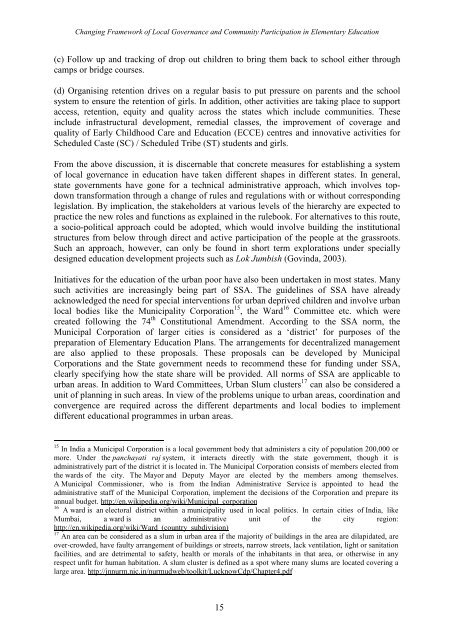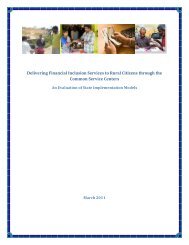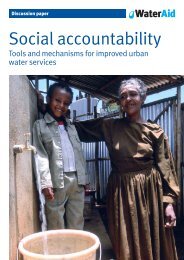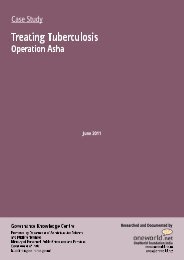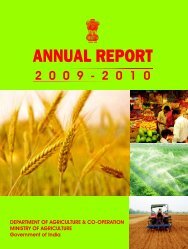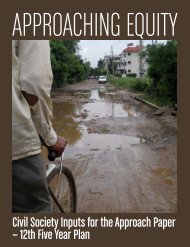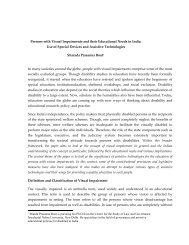Changing Framework of Local Governance and - Create
Changing Framework of Local Governance and - Create
Changing Framework of Local Governance and - Create
You also want an ePaper? Increase the reach of your titles
YUMPU automatically turns print PDFs into web optimized ePapers that Google loves.
<strong>Changing</strong> <strong>Framework</strong> <strong>of</strong> <strong>Local</strong> <strong>Governance</strong> <strong>and</strong> Community Participation in Elementary Education(c) Follow up <strong>and</strong> tracking <strong>of</strong> drop out children to bring them back to school either throughcamps or bridge courses.(d) Organising retention drives on a regular basis to put pressure on parents <strong>and</strong> the schoolsystem to ensure the retention <strong>of</strong> girls. In addition, other activities are taking place to supportaccess, retention, equity <strong>and</strong> quality across the states which include communities. Theseinclude infrastructural development, remedial classes, the improvement <strong>of</strong> coverage <strong>and</strong>quality <strong>of</strong> Early Childhood Care <strong>and</strong> Education (ECCE) centres <strong>and</strong> innovative activities forScheduled Caste (SC) / Scheduled Tribe (ST) students <strong>and</strong> girls.From the above discussion, it is discernable that concrete measures for establishing a system<strong>of</strong> local governance in education have taken different shapes in different states. In general,state governments have gone for a technical administrative approach, which involves topdowntransformation through a change <strong>of</strong> rules <strong>and</strong> regulations with or without correspondinglegislation. By implication, the stakeholders at various levels <strong>of</strong> the hierarchy are expected topractice the new roles <strong>and</strong> functions as explained in the rulebook. For alternatives to this route,a socio-political approach could be adopted, which would involve building the institutionalstructures from below through direct <strong>and</strong> active participation <strong>of</strong> the people at the grassroots.Such an approach, however, can only be found in short term explorations under speciallydesigned education development projects such as Lok Jumbish (Govinda, 2003).Initiatives for the education <strong>of</strong> the urban poor have also been undertaken in most states. Manysuch activities are increasingly being part <strong>of</strong> SSA. The guidelines <strong>of</strong> SSA have alreadyacknowledged the need for special interventions for urban deprived children <strong>and</strong> involve urbanlocal bodies like the Municipality Corporation 15 , the Ward 16 Committee etc. which werecreated following the 74 th Constitutional Amendment. According to the SSA norm, theMunicipal Corporation <strong>of</strong> larger cities is considered as a ‘district’ for purposes <strong>of</strong> thepreparation <strong>of</strong> Elementary Education Plans. The arrangements for decentralized managementare also applied to these proposals. These proposals can be developed by MunicipalCorporations <strong>and</strong> the State government needs to recommend these for funding under SSA,clearly specifying how the state share will be provided. All norms <strong>of</strong> SSA are applicable tourban areas. In addition to Ward Committees, Urban Slum clusters 17 can also be considered aunit <strong>of</strong> planning in such areas. In view <strong>of</strong> the problems unique to urban areas, coordination <strong>and</strong>convergence are required across the different departments <strong>and</strong> local bodies to implementdifferent educational programmes in urban areas.15 In India a Municipal Corporation is a local government body that administers a city <strong>of</strong> population 200,000 ormore. Under the panchayati raj system, it interacts directly with the state government, though it isadministratively part <strong>of</strong> the district it is located in. The Municipal Corporation consists <strong>of</strong> members elected fromthe wards <strong>of</strong> the city. The Mayor <strong>and</strong> Deputy Mayor are elected by the members among themselves.A Municipal Commissioner, who is from the Indian Administrative Service is appointed to head theadministrative staff <strong>of</strong> the Municipal Corporation, implement the decisions <strong>of</strong> the Corporation <strong>and</strong> prepare itsannual budget. http://en.wikipedia.org/wiki/Municipal_corporation16 A ward is an electoral district within a municipality used in local politics. In certain cities <strong>of</strong> India, likeMumbai, a ward is an administrative unit <strong>of</strong> the city region:http://en.wikipedia.org/wiki/Ward_(country_subdivision)17 An area can be considered as a slum in urban area if the majority <strong>of</strong> buildings in the area are dilapidated, areover-crowded, have faulty arrangement <strong>of</strong> buildings or streets, narrow streets, lack ventilation, light or sanitationfacilities, <strong>and</strong> are detrimental to safety, health or morals <strong>of</strong> the inhabitants in that area, or otherwise in anyrespect unfit for human habitation. A slum cluster is defined as a spot where many slums are located covering alarge area. http://jnnurm.nic.in/nurmudweb/toolkit/LucknowCdp/Chapter4.pdf15


